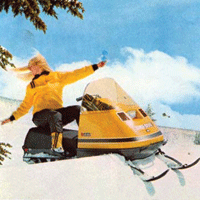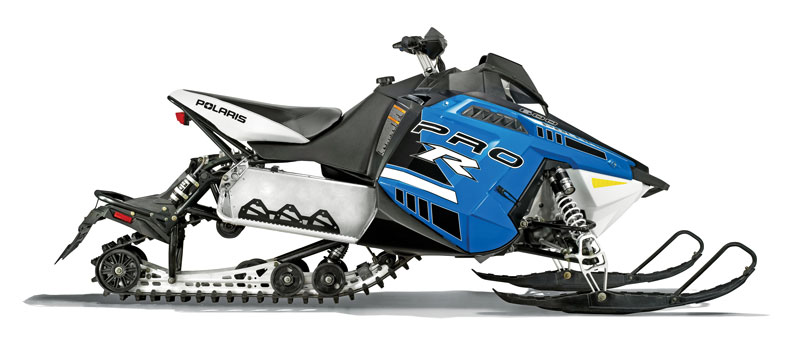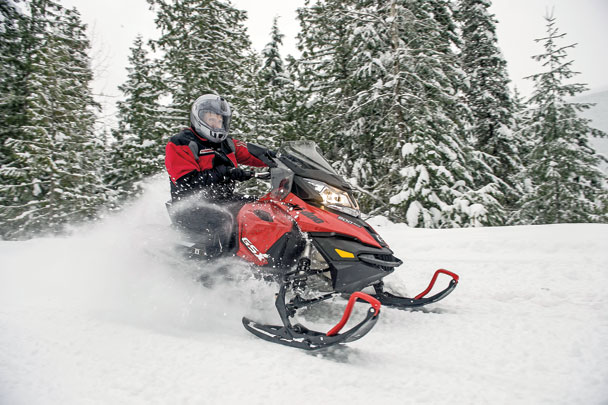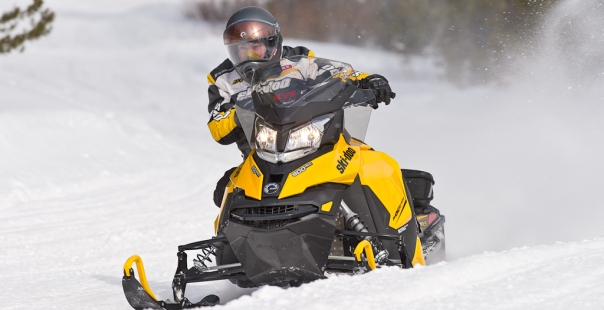In Ski-Doo speak, “X” stands for “extreme” and “RS” means “racer special.” So, it should come as no surprise that the X-RS shines when charging extremely hard through the harsh moguls like a wannabe snocross or cross-country racer.
We’ve liked previous X-RS models in general, but the suspension was harsh in some conditions. That changes with the rMotion. This new king of rear suspension ride quality sucks up the bumps, forgives mistakes and eats up energy from the terrain unlike anything else. That tingling sensation up your spine after slamming into the face of a hard mogul is erased by the rMotion skid. The ride has gotten softer, thanks to low-speed shock valving and spring rates, without giving up a lot of the anti-bottoming effects. Perhaps the adjustability of the rMotion is the secret, as it can be set soft enough for a compliant ride, but we could not find the bottom when bashing through deep moguls. The suspension is damped with KYB Pro 40 shocks that offer remote reservoirs with single knob compression adjustment, which is easy to access and easy to operate.

Although we loved the rMotion performance, the remote quick adjustment controls on the running boards of our test mule (a $400 upgrade) was an option none of us would select. Some feel that once a rider sets the suspension to his or her liking, there are infrequent need to making adjustments. If the need does arise, access and adjustments inside the track are pretty easy. The look of the adjustment knobs on the running board did not appeal to our group, and it just seems like they will get in the way, especially if you end up goofing around off trail.
Some test riders feel that the rMotion rear suspension works so well that it makes the Ski-Doo front seem like it needs improvement. The “twitchiness” of the XP chassis which has long been criticized by some has become more noticeable now — almost like how when snowmobile engines got quieter, all of a sudden the howl of the track started bugging many snowmobilers. The rear end is so capably controlled by the rMotion that the bump steer up front stood out in both trail chop and big mogul sections. Mid-corner correction and a quick knifing at the bars were occasionally needed.
Despite this nervousness on especially rough trails, none of our test riders felt the sled was unpredictable or a challenge to control, but it did require more attention in those conditions. On a smooth trail or even one with light scuttle, the MX Z X-RS handled beautifully. The chassis feels light, nimble and compact, and the steering effort is amazingly light, almost like it had electronic power steering in most situations, despite the fact that the new Pilot 5.7R ski has with a deeper keel, which usually comes with increased steering effort.
We’ve written often about the E-TEC 800R engine. It’s a high-tech marvel that’s a known-quantity to many snowmobilers, producing roughly 160hp with a broad powerband and a meaty sound, yet a delicate sound at idle that is one of many factors that makes this the posterchild for clean-burning two-strokes. It’s efficient, powerful and fun.
Also a surprisingly known quantity on the X-RS is the look and ergonomics of this 2013 model. While most other MX Z models come in the new REV-XS platform this year, we were shocked to see this showcase model stick with the older REV-XP. One might think that a consumer who shells out a wad of cash for a top-end X-RS would want the latest and greatest, but apparently Ski-Doo thought differently. One of our test riders predicted that Doo will see sales of the X-RS drop off in 2013 because of this, as some consumers will wait a year and get the 2014, which is sure to come with the new features (if, of course, the X-RS is back as we anticipate).

But that’s not to say that the REV-XP is a disaster — far from it, it has kept Doo at the top of the heap in market share each of its five years. On the X-RS, most of our riders found the seat to be their liking, though some said it felt too tall. Its foam is the correct stiffness for comfort, and feels grippy in all conditions without limiting side-to-side transitions. The X-RS comes with wider, reinforced running boards a more-forward steering post, an upgraded Brembo brake including a stainless steel-braided brake line and racing-style pads, straight aluminum bars with J-hooks and a high-end gauge with playback for tuning purposes. Our unit also came with electric start (another $400 upgrade).
The X-RS still looks like a race sled but it’s less “stickered up” than previous years. The 2013 version has cleaner lines and the paint scheme looks more thought out, instead of a bunch of racing stickers of various color and size slapped on the hood. Some consumers may like that “racer” look; others may have felt it cheapened the look of the sled. Most in our group preferred the current look, complete with copper-colored lettering, and think it may appeal to a younger crowd.
Overall, the MX Z X-RS E-TEC 800R is rowdy and fun, yet it’s refined. It encourages a certain amount of hooliganism, but it still has manners. Among the two, the X-RS received a little more praise in the engine, suspension and fit/finish categories, enough so that it the wins “the race” in this comparison.
Ski-Doo MX Z X-RS E-TEC 800R – $13,249
Claimed dry weight: 463 pounds Engine: 799cc liquid-cooled twin, E-TEC direct injection, bore/stroke 82x76mm Track: 15x120x1.25 RipSaw




